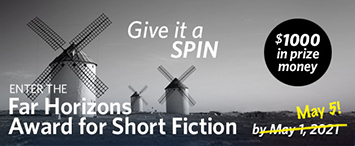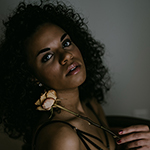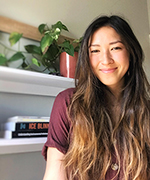|
|
One day left to submit!

Our deadline has been extended to May 5 at 11:59pm PDT! This contest is specifically for those who have yet to publish their fiction in book form. Submit your short story (maximum 3,500 words) for a chance to win $1,000 CAD and publication!
Entry fee is discounted and comes with a one-year print subscription:
$25 CAD for each entry from Canada
$30 CAD for each entry from the USA
$35 CAD for each entry from elsewhere
Additional entries cost $15 CAD each, no limit!
This year's judge is Francine Cunningham.
Full contest guidelines on our website.
spring issue interview with Leslie Joy Ahenda on poetry
 Malahat Review volunteer and past contributor Kathy Mak talks with the spring issue #214 contributor about mythos, momentum, and meaning. Malahat Review volunteer and past contributor Kathy Mak talks with the spring issue #214 contributor about mythos, momentum, and meaning.
KM: Of the trio of poems, “Venus” begins with a reference to Erik Olson’s oil painting. As a deity who represents love, victory, and sexuality, what drew you to writing about Venus and the roles she holds?
LJA: I was drawn first and foremost to the planet. Calling upon the goddess became necessary only because it is impossible to divorce the name “Venus” from its mythos. When I went off researching the planet to give it personhood and explore the feelings that I had, I knew it would be disingenuous to ignore the mythology of the goddess. But what really fascinates me is the body of the planet itself. The way it moves and functions, and what its behaviour evokes. I consider this poem to be quite literal, although I understand that very few people will read it that way.
I often begin in the scientific when I write poetry. I think that I was meant to be a scientist, but unfortunately, I can’t do math. So instead of pursuing study in a scientific field, I write science poems. This way, I can say, “look at this incredible feat of nature! Isn’t it spectacular?” If people are intrigued by the subject matter, then I feel I’ve succeeded as a scientist. And if people read these poems and pick up on a metaphor that speaks to them, if the poems make them feel any type of way, then I feel I’ve succeeded as a poet.
Read the rest of Leslie Joy Ahenda's interview.
spring issue interview with Rhiannon Ng Cheng Hin on poetry
 Malahat Review Managing Editor L'Amour Lisik talks with the spring issue #214 contributor about Mauritius, methods for discovering a poem’s form, and memory as a molecule of water. Malahat Review Managing Editor L'Amour Lisik talks with the spring issue #214 contributor about Mauritius, methods for discovering a poem’s form, and memory as a molecule of water.
LL: “Lessons in Southern Water Cycles” begins in Pereybère, Mauritius—a small volcanic island off the coast of Madagascar, in the Indian Ocean—and makes its way to Northern Ontario. As someone who’s also part of the Chinese-Mauritian diaspora, sense of place is something I seek out when I read. How important is sense of place in your writing? Are there any writers who you look to for inspiration?
RNCH: It’s always exciting to meet other members of the Chinese-Mauritian community! My concept of place is constantly shifting as I think “place” can mean many different things. A place can be a physical location, a person, a point in one’s deep sense memory, a moment in time – or all of these things in flux with one another. And perhaps places can be returned to, forgotten, longed for…they can decay and they can re-manifest in one’s life – or come back alive, as this poem suggests – many generations later. Like many island nations, Mauritius is so small that I’ve seen it omitted from children’s globes and pocket atlases as though its existence is arbitrary. The concept of place, in its many forms, is important in these poems because it allows for a reconstitution of this very real island that is raw with family histories, traditions, cultures, and imperial traumas. I think place also forces us to ask ourselves certain questions – how are we subconsciously negotiating and re-negotiating our identities in relation to place? In what ways are we, as diasporic people, tempted to exotify ancestral places? In what ways is the concept of place violent? There are so many writers I look to for inspiration when it comes to holding the reader with care in a specific place, or creating a dislocation from place – Kaie Kellough, Kevin Adonis Browne, Louise B. Halfe, Canisia Lubrin, Don Domanski, and others. In their different ways they are able to take the reader and ground them in a physical, temporal, sensory, or cultural place, and ask, who are you now, and what have you left behind?
Read the rest of Rhiannon Ng Cheng Hin's interview.
|
|
|
|
|
|
|
|
|
|
|
|